Seborrheic Dermatitis Hair Loss: 4 Top Treatments
A combination of medications and hygiene are keys to managing this form of hair loss.

Image: ShutterStock
Seborrheic dermatitis hair loss recently came up on our hair care radar, which made us curious. After all, seborrheic dermatitis is a skin condition that causes yellow-to-white flakes to appear on your scalp, body, and face and has no direct link to hair loss.
Seborrheic dermatitis makes your scalp feel itchy. When you aggressively scratch your scalp, you damage hair follicles, leading to hair loss. Keep reading to learn about the causes and treatment of seborrheic dermatitis and its relation to hair loss.
In This Article
Seborrheic Dermatitis: What Is It And What Are The Causes?
Seborrheic dermatitis is an inflammatory condition that causes itchy and scaly inflammatory patches on the skin.
It can occur in the body’s oil-producing areas, like the face, upper chest, scalp, and back. Seborrheic dermatitis on the scalp is known as dandruff (1), (2).
Despite its prevalence, the causes of seborrheic dermatitis are not well understood. Experts believe that it may be caused by a combination of factors like environmental conditions, fungal colonization (Malassezia), and genetic susceptibility.
Research showed a strong association between dandruff and the overgrowth of Malassezia. This yeast-like fungus naturally occurs on the scalp and other sebum-producing areas. It feeds on the oil and sebum, leaving behind some unsaturates on the skin. Increased sebum production triggers high fungal activity on the scalp, leading to inflammation, irritability, and flaking (3)
Seborrheic dermatitis is extremely common in men and tends to run in families. Changing lifestyles and increasing stress are the reasons increasing number of women are now diagnosed with it.
Seborrheic dermatitis is prevalent in people with immune-compromised conditions like (1):
- HIV/AIDS
- Lymphomai Cancer of the lymphatic system that arises from the abnormal growth of white blood cells.
- Organ transplant recipients
It also affects those with neurological disorders like:
- Parkinson’s disease
- Epilepsyi Central nervous system disorder characterized by seizures, unconsciousness, or odd behavior due to brain activity fluctuations.
- Chronic alcoholic pancreatitisi A prolonged, painful condition brought on by pancreatic inflammation from heavy, long-term alcohol use.
- Mood depression
- Spinal cord injury
Seborrheic dermatitis or dandruff has several symptoms. Let’s take a look at them.
Key Takeaways
- Seborrheic dermatitis is an inflammatory disorder that creates itchy, flaky inflammatory patches on the skin.
- The intense itching caused by seborrheic dermatitis can make you scratch your head and damage the hair follicles, thus causing hair loss.
- You can treat seborrheic dermatitis with antifungal products, topical corticosteroids, or natural remedies like lemon, aloe vera, honey, and tea tree oil.
- Decreasing the use of styling products, avoiding harsh shampoos, and maintaining hygiene will speed up the healing process.
Symptoms Of Seborrheic Dermatitis
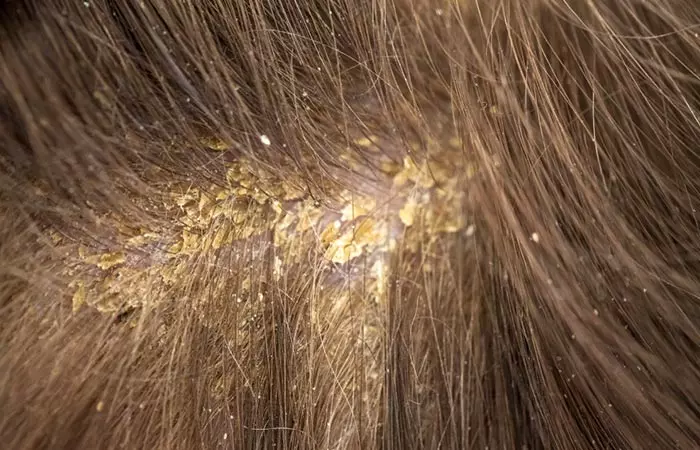
- White or yellow greasy flakes on the scalp
- Red and itchy patches on ears, eyebrows, hairline, nose, and the chest
- Sensitive skin that is sore to touch
Severe dandruff may lead to hair loss. The following sections answer common questions related to seborrheic dermatitis and hair loss. Scroll down.
Can Seborrheic Dermatitis Cause Hair Loss?

Seborrheic dermatitis does not cause hair loss. However, it affects scalp health, and the extreme itchiness can trigger the urge to scratch. This may damage the hair follicles, causing hair loss.
Moreover, an irritated scalp does not support healthy hair growth. Severe seborrheic dermatitis may lead to hair fall or thinning. However, the hair loss is not permanent.
 Did You Know?
Did You Know?Is Seborrheic Dermatitis Hair Loss Permanent?
No. It is temporary if treated in a timely and proper manner. If you notice dandruff that does not go away with topical anti-dandruff shampoos and products, it might be a severe case of seborrheic dermatitis that demands aggressive treatment. Consult a dermatologist immediately for proper treatment. After diagnosis, your doctor may suggest any or a combination of treatments mentioned below.
Seborrheic Dermatitis: What Are The Treatment Options?
Treating seborrheic dermatitis focuses on reducing the proliferation of Malassezia and minimizing inflammation and irritation. The doctor may use topical and systemic therapy (1).
1. Antifungal Products And Ointments

The doctor may prescribe antifungal shampoos, gels, creams, and lotions containing ingredients like 2% ketoconazole, 1% bifonazole, miconazole, 1.5% ciclopirox olamine, 2.5% selenium sulfide, and 1% zinc pyrithione.
2. Corticosteroids And Immunomodulators
Topical corticosteroids like hydrocortisone, betamethasone dipropionate, desonide, fluocinolone reduce inflammation and skin irritation.
However, prolonged use of steroids may cause hypopigmentation, folliculitis, and skin atrophy (skin thinning).
Immunomodulators like 1% pimecrolimus cream and 0.1% tacrolimus ointment inhibit cytokine (group of proteins and peptides) production by the T-cells. They help maintain the skin. However, prolonged use may increase the risk of lymphoma and malignancy. Always use these medications under the doctor’s supervision.
3. Oral Medications
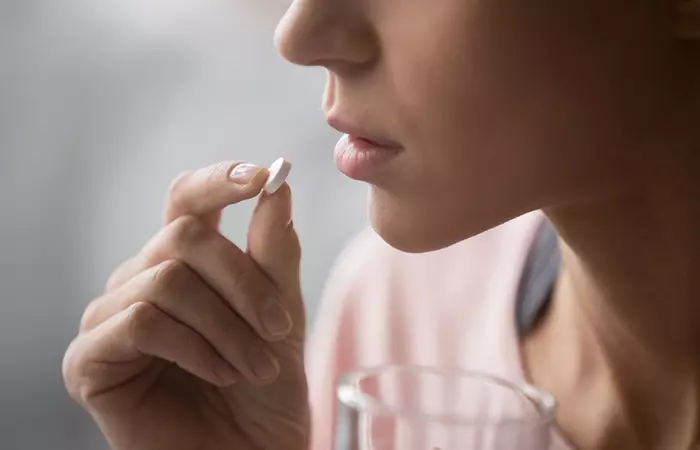
Oral medicines like itraconazole and terbinafine have an anti-inflammatory effect and inhibit the fungal cell wall synthesis. This soothes your skin. However, abuse of itraconazole may cause liver toxicity, and terbinafine may cause insomnia.
4. Other Topical Treatments
The doctor may also suggest shampoos and products containing coal tar, lithium gluconate, and metronidazole and phototherapyi Treatment method to clear skin conditions where the entire body is briefly exposed to a specific wavelength of UV radiation. (UVB) to inhibit cell proliferation and free radicals and reduce inflammation.
If you have mild dandruff, you may also try home remedies to manage the condition.
 Quick Tip
Quick TipNatural Remedies To Manage Seborrheic Dermatitis

- Lemon: You can mix lemon peel powder with white wine, alum, fresh turmeric, and salt and apply it to inflamed skin for relief (4). You can also apply a mixture of curd and lemon juice to your scalp, leave it on for 20 minutes, and rinse it off with a shampoo.
- Aloe Vera: Aloe vera gel has anti-inflammatory properties, and rubbing it on the skin can soothe itching and irritation (4). So it is a great home remedy for itchy scalp.
- Honey: Honey is used in traditional medicine to soothe swelling and irritation caused by seborrheic dermatitis. Mix honey with water and apply it to the affected area and wash it off (4). You can use ACV for rinsing after the wash.
- Tea Tree Oil: Experts recommend using tea tree oil for dandruff due to its antifungal benefits. You can use shampoo containing tea tree oil (2), (4). You can add a few drops of rosemary oil to tea tree oil and apply the mixture to the affected area. However, essential oils may irritate the skin. Hence, do a patch test before using it.
Taking care of your scalp and hair and a few other lifestyle changes may speed up the healing process. Follow the tips below for faster healing.
Lifestyle Changes For Fast Healing
1. Reduce The Use Of Styling Products
Go slow with styling products like hair sprays and gels. Avoid them while undergoing treatment. Even after recovery, avoid exposing the scalp to the chemicals and preservatives in the hairstyling products.
2. Avoid Harsh Shampoos
Excess use of harsh shampoos can dry out the scalp, promoting excess hair sebum production. Use mild and soothing shampoos without drying alcohols. Also, avoid frequent shampooing.
3. Maintain Hygiene
Keep your scalp clean and dry. Use a clarifying shampoo once in a while to clean excess dirt and product buildup. This may help avoid flare-ups.
A hair care blogger recounts her experience with seborrheic dermatitis on her blog and observes the impact of her hair care process as follows: “I wash my hair every week with shampoo. This keeps my scalp clean. I don’t use medicated shampoo because my eczema isn’t horrible (i).” She adds, “I don’t leave products on my scalp, not even natural oils. I realize my scalp gets very irritated when there are products on it.”
4. Avoid Leaving Oil In Your Hair For Long
You can apply hair oil 10 minutes before a shower, once in 15-20 days. Keeping oil on the scalp for over a few hours can worsen seborrheic dermatitis.
Seborrheic dermatitis and psoriasis are often confused, so let’s understand the difference between them.
Seborrheic Dermatitis Vs. Psoriasis
Seborrheic dermatitis and psoriasis are common skin conditions with similar symptoms yet distinct differences. Seborrheic dermatitis, often known as dandruff when it affects the scalp, is characterized by red, itchy, and flaky skin. It commonly occurs in oily areas, such as the scalp, face, and chest. Although the etiology is unclear, genetics and environmental factors can contribute to its development (5).
In contrast, psoriasis is an autoimmune condition that hastens skin cell growth, causing cells to accumulate rapidly on the surface. This leads to the formation of thick, silvery scales and itchy, dry, and sometimes painful patches. Psoriasis can affect any part of the body and often appears in cycles of flare-ups and remission. Unlike seborrheic dermatitis, psoriasis is an immune response, and it can affect joints in some cases, leading to psoriatic arthritis (6).
Infographic: Food Tips For Seborrheic Dermatitis
Dietary choices have no direct link to seborrheic dermatitis. But that doesn’t rule out the possibility that your food has a role in your flare-ups. Eat meals that help your immune function and protect your overall health. As a result, you might notice a reduction in symptoms. Check out the infographic below to see what foods you should consume and what to avoid to help reduce the flare-ups.
Some thing wrong with infographic shortcode. please verify shortcode syntax
In A Nutshell
Don’t worry if you notice seborrheic dermatitis hair loss. This type of hair loss is most likely temporary. This inflammatory condition causes intense itching, leading to hair follicle damage and, subsequently, hair loss. You can manage seborrheic dermatitis with the right mix of medications, topical creams, and correct hair care practices. Follow a balanced diet, maintain a healthy lifestyle, and drink lots of water to promote the health of your scalp and locks. If the condition persists, consult your healthcare provider to determine what is causing this hair trouble and what your next course of action should be.
Frequently Asked Questions
Does seborrheic dermatitis impact hair growth?
Yes, seborrheic dermatitis can negatively affect hair growth, as it causes inflammation and itching that may lead to hair thinning or shedding if left untreated over time.
What is the most effective way to manage severe seborrheic dermatitis flare-ups?
Some of the best ways to manage severe flare-ups include using medicated shampoos, topical steroids, antifungal creams, and moisturizing regularly.
Can seborrheic dermatitis cause shedding?
Yes. Seborrheic dermatitis may cause hair shedding. It causes the scalp to become itchy, and when left untreated, it can weaken and damage hair follicles leading to breakage and shedding.
Can I use Rogaine if I have seborrheic dermatitis?
No. Rogaine (minoxidil) is generally recommended to stimulate hair growth. It may dry out your scalp leading to further flaking if it has an alcoholic formulation. Please consult a doctor before using it to manage seborrheic dermatitis.
Does Vitamin D help seborrheic dermatitis?
Research indicated that vitamin D supplementation could decrease the recurrence of seborrheic dermatitis in people with a vitamin D deficiency (5).
Can biotin help seborrheic dermatitis?
Yes. Biotin supplementation may improve seborrheic dermatitis and reduce the risk of alopecia and lesions caused by the condition (6) (7). However, this may only work if a biotin deficiency causes the issue.
Is sunlight good for seborrheic dermatitis?
Sun exposure is said to be good for those with seborrheic dermatitis as it inhibits fungal growth. But, overexposure to the sun may worsen the condition, especially when coupled with a hot and humid climate.
Can coconut oil help seborrheic dermatitis?
Coconut oil has antifungal properties that may help manage seborrheic dermatitis, and it penetrates the hair shaft to nourish from within without stripping away protein and moisture.
Should I wash my hair every day if I have seborrheic dermatitis?
You may wash your hair every day. However, the frequency of medicated shampoos depends on the severity of the condition. For severe symptoms, shampoo 2-3 times a week and reduce the frequency to once a week when the symptoms subside.
Does not washing hair help seborrheic dermatitis?
No. Not washing your hair may not help seborrheic dermatitis. Instead, it may make your scalp drier and worsen the symptoms. Also, it is best to consult a doctor to know how often you should wash.
Does conditioner worsen seborrheic dermatitis?
Conditioners may sometimes worsen seborrheic dermatitis because they deposit oils and other agents on your scalp.
Learn how to get rid of seborrheic dermatitis by following the 4 amazing tips listed in this video! Now, go check out this video to get the most helpful advice on managing this skin condition.
Personal Experience: Source
StyleCraze's articles are interwoven with authentic personal narratives that provide depth and resonance to our content. Below are the sources of the personal accounts referenced in this article.
i. How I take care of my scalp eczema (seborrheic dermatitis)https://jewelthehair.wordpress.com/2019/05/08/how-i-take-care-of-my-natural-hair-with-scalp-eczema-seborrheic-dermatitis/
References
Articles on StyleCraze are backed by verified information from peer-reviewed and academic research papers, reputed organizations, research institutions, and medical associations to ensure accuracy and relevance. Read our editorial policy to learn more.
- Seborrheic Dermatitis and Dandruff: A Comprehensive Review
https://www.ncbi.nlm.nih.gov/pmc/articles/PMC4852869/ - Seborrheic Dermatitis.
https://www.ncbi.nlm.nih.gov/pmc/articles/PMC2888552/ - The role of sebaceous gland activity and scalp microfloral metabolism in the etiology of seborrheic dermatitis and dandruff
https://pubmed.ncbi.nlm.nih.gov/16382662/
- Seborrheic Dermatitis and Traditional Treatments.
https://www.researchgate.net/profile/Hoi_Ht/publication/339265220_Seborrheic_Dermatitis_and_Traditional_Treatments/links/5ecd1c75299bf1c67d1c0dde/Seborrheic-Dermatitis-and-Traditional-Treatments.pdf - The Effect Of Vitamin D Supplementation On Recurrences Of Seborrheic Dermatitis
https://www.researchgate.net/publication/316718366_The_effect_of_vitamin_d_supplementation_on_recurrences_of_seborrheic_dermatitis - Generalized Seborrhoeic Dermatitis Clinical And Therapeutic Data Of 25 Patients
https://www.researchgate.net/publication/23006156_Generalized_seborrhoeic_dermatitis_Clinical_and_therapeutic_data_of_25_patients - Seborrheic Dermatitis and Dandruff: A Comprehensive Review
https://www.ncbi.nlm.nih.gov/pmc/articles/PMC4852869/
Read full bio of Dr. Sonam Jeswani Ramrakhiani
Read full bio of Anjali Sayee
Read full bio of Eshna Das
Read full bio of Krati Darak












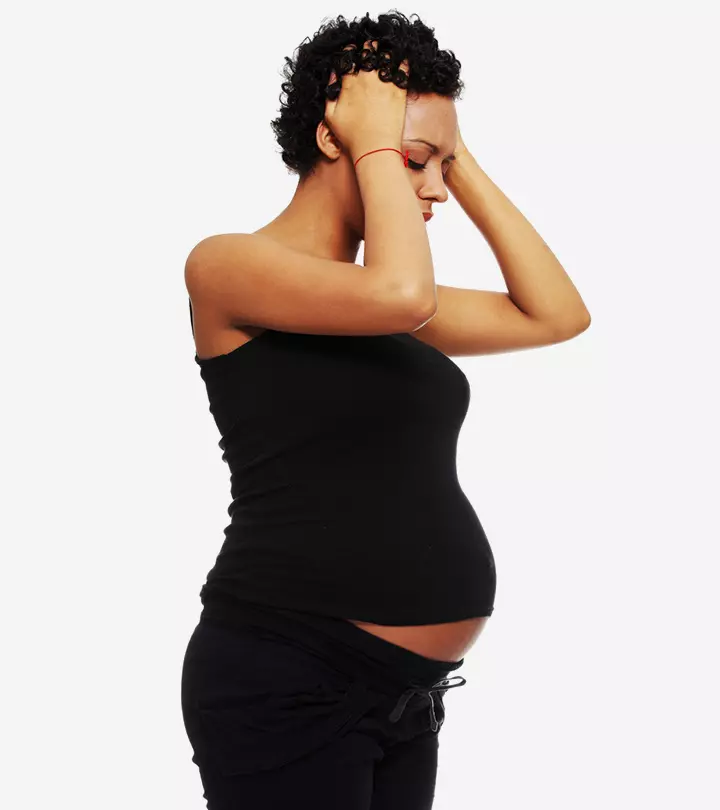

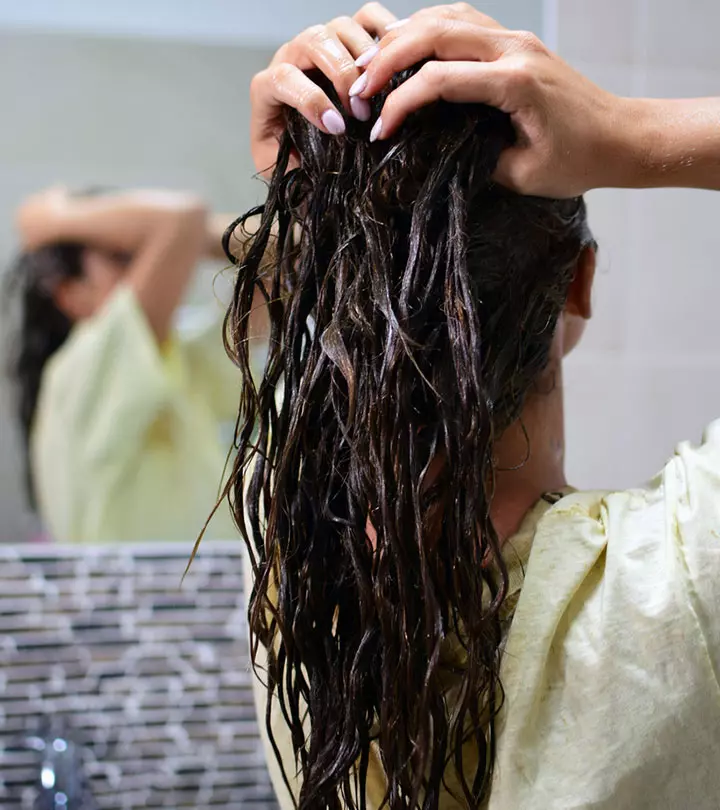






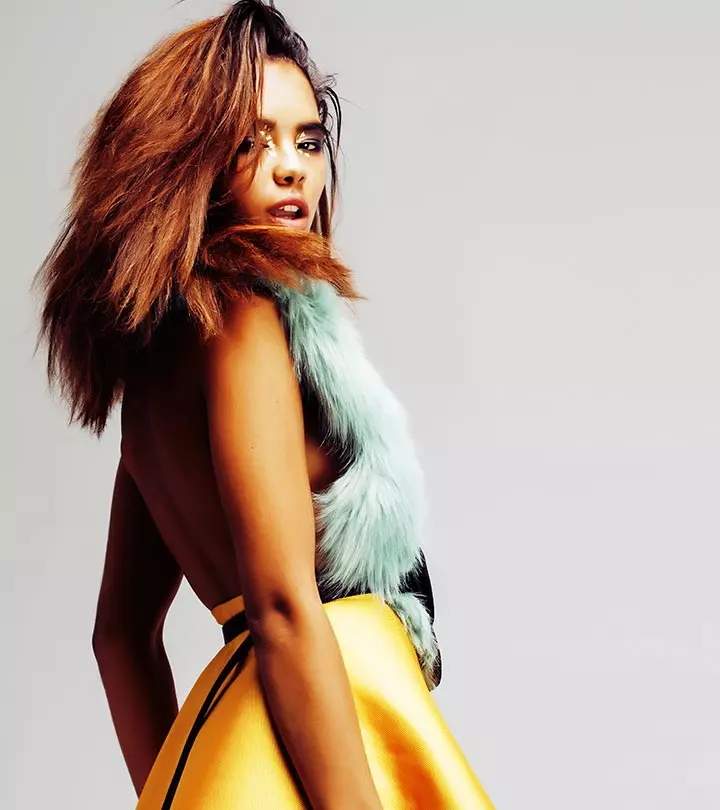





Community Experiences
Join the conversation and become a part of our empowering community! Share your stories, experiences, and insights to connect with other beauty, lifestyle, and health enthusiasts.